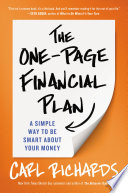

The first key idea in 'The One-Page Financial Plan' is the importance of clarity in setting financial goals. The author emphasizes that without clear, well-defined goals, individuals may find themselves drifting financially, lacking direction and purpose. The book encourages readers to think deeply about what they truly want in life, whether it’s saving for retirement, buying a home, funding a child's education, or traveling the world. By articulating these goals, one can create a roadmap for their financial journey. The author suggests using the SMART criteria—Specific, Measurable, Achievable, Relevant, and Time-bound—to ensure that goals are not only aspirational but also actionable. This clarity helps individuals prioritize their financial decisions and allocate resources effectively, leading to a more fulfilling financial life.
Continue readingThe second key idea is the necessity of having a financial plan. The author argues that a financial plan is not just for the wealthy or business owners; it is essential for everyone. A financial plan serves as a blueprint for achieving financial goals and provides a framework for making informed decisions. The book outlines the components of a solid financial plan, including budgeting, saving, investing, and insurance. It emphasizes that a financial plan should be dynamic and revisited regularly to adapt to changing circumstances and goals. The author also highlights that having a plan reduces anxiety and uncertainty, empowering individuals to take control of their financial futures. By developing a one-page financial plan, readers can simplify complex financial concepts and make them more accessible.
Continue readingIn this book, the author delves into behavioral finance, which explores how psychological factors influence financial decision-making. One of the key insights is that emotions and cognitive biases often lead individuals to make poor financial choices. The author discusses various biases, such as overconfidence, loss aversion, and anchoring, and how they can derail financial plans. By understanding these biases, readers can develop strategies to mitigate their effects, such as setting up automatic savings or seeking professional advice. The book encourages readers to cultivate a mindset of awareness and discipline, which can lead to better financial outcomes. Recognizing the emotional aspects of finance allows individuals to make more rational decisions, aligning their actions with their long-term goals.
Continue readingThe fourth key idea revolves around the basics of investing. The author emphasizes that investing is a crucial part of building wealth and achieving financial goals. However, many people feel intimidated by the idea of investing, often due to a lack of knowledge. The book breaks down complex investment concepts into simple, digestible information. It discusses the importance of asset allocation, diversification, and understanding risk tolerance. The author advocates for a long-term investment strategy, highlighting the power of compound interest over time. Additionally, the book encourages readers to start investing early, even if it’s a small amount, to take advantage of market growth. By demystifying investing, the author empowers readers to take actionable steps toward wealth accumulation.
Continue readingInsurance is a critical component of a comprehensive financial plan, and this book does not overlook its importance. The author explains that insurance protects against unforeseen events that could derail financial goals, such as illness, accidents, or property loss. The book discusses different types of insurance, including health, life, auto, and homeowner’s insurance, and the role each plays in a financial plan. The author emphasizes the need to assess personal risk and determine appropriate coverage levels. By understanding insurance, readers can better protect their assets and ensure that they are financially secure in the face of adversity. This proactive approach to risk management is essential for maintaining financial stability.
Continue readingThe sixth key idea is the necessity of regular review and adjustment of one’s financial plan. The author stresses that life is dynamic, and financial situations can change due to various factors, such as job changes, family dynamics, or economic shifts. Therefore, it is crucial to revisit the financial plan periodically to ensure it remains relevant and aligned with current goals. The book provides guidance on how to conduct these reviews, suggesting that individuals set specific times—such as annually or semi-annually—to assess their progress. This process not only helps in tracking achievements but also in identifying areas that may need adjustment. By fostering a habit of regular review, readers can stay on track and make necessary changes proactively.
Continue readingThe final key idea is the emphasis on simplicity and actionability in financial planning. The author advocates for creating a one-page financial plan to make the process less overwhelming and more manageable. By distilling complex financial information into a single page, individuals can easily reference their goals, strategies, and action steps. This approach encourages action, as it eliminates the intimidation that often accompanies detailed financial plans. The book provides templates and examples to help readers create their own one-page plans. This simplicity allows individuals to focus on what matters most and take consistent steps toward achieving their financial objectives.
Continue reading